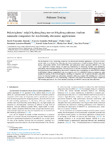Polyethylene/ Poly(3-hydroxybutyrate-co-3-hydroxyvalerate /Carbon Nanotube Composites for Eco-Friendly Electronic Applications

Use este enlace para citar
http://hdl.handle.net/2183/31032
A non ser que se indique outra cousa, a licenza do ítem descríbese como Attribution-NonCommercial-NoDerivatives 4.0 International (CC BY-NC-ND 4.0)
Coleccións
Metadatos
Mostrar o rexistro completo do ítemTítulo
Polyethylene/ Poly(3-hydroxybutyrate-co-3-hydroxyvalerate /Carbon Nanotube Composites for Eco-Friendly Electronic ApplicationsAutor(es)
Data
2022-08Cita bibliográfica
D. Fernández Armada, V. González Rodríguez, P. Costa, S. Lanceros-Mendez, G. Arias-Ferreiro, M.-J. Abad, A. Ares-Pernas, Polyethylene/ poly(3-hydroxybutyrate-co-3-hydroxyvalerate /carbon nanotube composites for eco-friendly electronic applications, Polymer Testing. 112 (2022) 107642. https://doi.org/10.1016/j.polymertesting.2022.107642
Resumo
[Abstract] The development of new conducting composites, for electric and electronic applications, with lower environmental impact is a relevant issue. Blending poly (3-hydroxybutyrate-co-3-hydroxyvalerate (PHBV) with high-density polyethylene (HDPE), 50/50 HDPE/PHBV, and multiwalled carbon nanotubes (MWCNTs) (3.5 and 7.5%), represents a suitable strategy for improving sustainability of conducting polymers while maintaining procesability and functional performance. The study focuses on thermal, mechanical, morphological, rheological, electrical properties and EMI shielding effectiveness. Composites show a morphology in which MWCNTs remains in HDPE phase. Without compatibilizer, only the composite with 7.5% of MWCNTs achieves a conductivity value suitable for reaching 20 dB of electromagnetic shielding. In composites with PE grafted with maleic anhydride (0.5%) the electrical conductivity substantially increased, achieving a suitable EMI shielding level with lower proportion of nanotubes (5 wt%). Summarizing, composites with reduced environmental impact, suitable for EMI shielding applications, have been obtained optimizing the MWCNTs amount and their dispersion.
Palabras chave
PHBV
Polymer composites
Carbon nanotubes
Electrical conductivity
Rheology
EMI
Polymer composites
Carbon nanotubes
Electrical conductivity
Rheology
EMI
Descrición
Financiado para publicación en acceso aberto: Universidade da Coruña/CISUG
Versión do editor
Dereitos
Attribution-NonCommercial-NoDerivatives 4.0 International (CC BY-NC-ND 4.0)
ISSN
0142-9418






